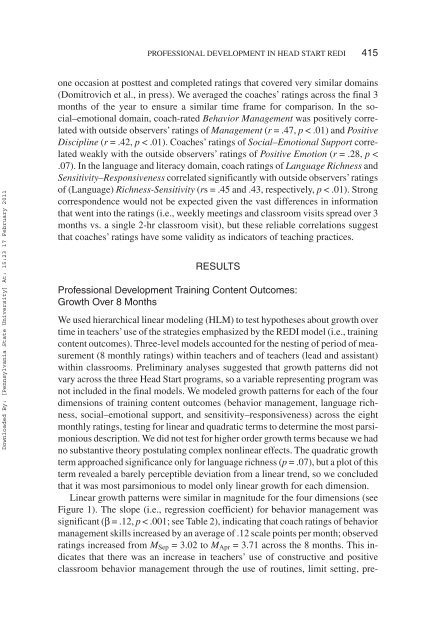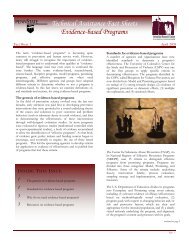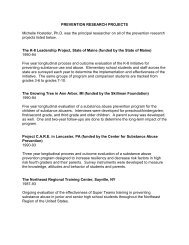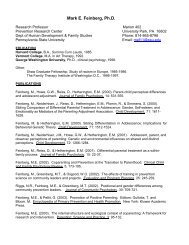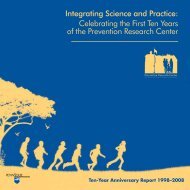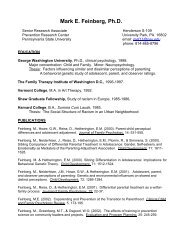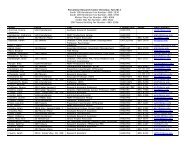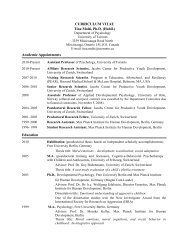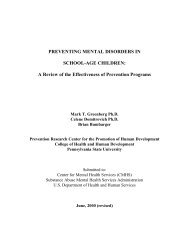Early Education & Development Individual Factors Associated With ...
Early Education & Development Individual Factors Associated With ...
Early Education & Development Individual Factors Associated With ...
You also want an ePaper? Increase the reach of your titles
YUMPU automatically turns print PDFs into web optimized ePapers that Google loves.
PROFESSIONAL DEVELOPMENT IN HEAD START REDI 415<br />
Downloaded By: [Pennsylvania State University] At: 15:23 17 February 2011<br />
one occasion at posttest and completed ratings that covered very similar domains<br />
(Domitrovich et al., in press). We averaged the coaches’ ratings across the final 3<br />
months of the year to ensure a similar time frame for comparison. In the social–emotional<br />
domain, coach-rated Behavior Management was positively correlated<br />
with outside observers’ ratings of Management (r = .47, p < .01) and Positive<br />
Discipline (r = .42, p < .01). Coaches’ ratings of Social–Emotional Support correlated<br />
weakly with the outside observers’ ratings of Positive Emotion (r = .28, p <<br />
.07). In the language and literacy domain, coach ratings of Language Richness and<br />
Sensitivity–Responsiveness correlated significantly with outside observers’ratings<br />
of (Language) Richness-Sensitivity (rs = .45 and .43, respectively, p < .01). Strong<br />
correspondence would not be expected given the vast differences in information<br />
that went into the ratings (i.e., weekly meetings and classroom visits spread over 3<br />
months vs. a single 2-hr classroom visit), but these reliable correlations suggest<br />
that coaches’ ratings have some validity as indicators of teaching practices.<br />
RESULTS<br />
Professional <strong>Development</strong> Training Content Outcomes:<br />
Growth Over 8 Months<br />
We used hierarchical linear modeling (HLM) to test hypotheses about growth over<br />
time in teachers’use of the strategies emphasized by the REDI model (i.e., training<br />
content outcomes). Three-level models accounted for the nesting of period of measurement<br />
(8 monthly ratings) within teachers and of teachers (lead and assistant)<br />
within classrooms. Preliminary analyses suggested that growth patterns did not<br />
vary across the three Head Start programs, so a variable representing program was<br />
not included in the final models. We modeled growth patterns for each of the four<br />
dimensions of training content outcomes (behavior management, language richness,<br />
social–emotional support, and sensitivity–responsiveness) across the eight<br />
monthly ratings, testing for linear and quadratic terms to determine the most parsimonious<br />
description. We did not test for higher order growth terms because we had<br />
no substantive theory postulating complex nonlinear effects. The quadratic growth<br />
term approached significance only for language richness (p = .07), but a plot of this<br />
term revealed a barely perceptible deviation from a linear trend, so we concluded<br />
that it was most parsimonious to model only linear growth for each dimension.<br />
Linear growth patterns were similar in magnitude for the four dimensions (see<br />
Figure 1). The slope (i.e., regression coefficient) for behavior management was<br />
significant (β = .12, p < .001; see Table 2), indicating that coach ratings of behavior<br />
management skills increased by an average of .12 scale points per month; observed<br />
ratings increased from M Sep = 3.02 to M Apr = 3.71 across the 8 months. This indicates<br />
that there was an increase in teachers’ use of constructive and positive<br />
classroom behavior management through the use of routines, limit setting, pre-


